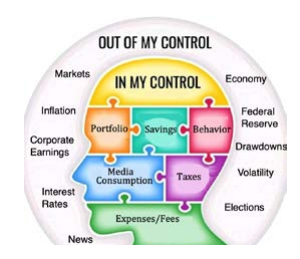Looking Behind and Ahead of 2023
In the world of investing and wealth accumulation, it is important to understand what we can and cannot control. 2022 was a challenging year for the markets with multiple factors such as the ongoing pandemic, the Russian war in Ukraine, rising interest rates and inflation and fears of a global recession causing volatility. While the future may be uncertain, there are certain elements of our financial well-being that we can control.
One of the most critical things we can control is our personal behaviour. This includes being mindful of the media we consume, and avoiding letting emotions sway our investment decisions. Instead, we should focus on developing and sticking to a well-thought-out plan that takes into account our savings, spending, portfolio construction, tax planning, and costs and fees. By making smart choices in these areas, we can maximize our chances of financial success.
On the other hand, there are many things that are beyond our control, such as inflation, stock markets, interest rates, the Federal Reserve, elections, the economy, corporate earnings, and geopolitical events. Trying to predict or control these factors is a futile task and instead, we should focus on what we can control. It's also worth noting that in times of market volatility, it can be tempting to make hasty investment decisions based on short-term news and market movements.
However, by focusing on what we can control, and sticking to a long-term plan, we can avoid emotional investing and increase our chances of success.
While we expect there will always be uncertainty and volatility in the markets, we expect the current volatility to continue for the next 6-12 months. We all have control over certain elements of our financial well-being by focusing on our savings, spending, portfolio construction, tax planning, and costs and fees, and avoiding being swayed by the media and emotions, we can increase our chances of financial success. Sticking to a good long-term plan is always a better option than trying to predict the unpredictable by staring into a cracked crystal ball.
Please reach out should you have any questions or concerns about market conditions and your portfolio is affected.
“The true investor welcomes volatility….a wildly fluctuating market means that irrationally low prices will periodically be attached to solid businesses.” ~ Warren Buffett
Graphic source: @mindfulenough | Infographic design by @agrassoblog for educational and motivational purposes
Health, Happiness & Success!
Deb, Kelly, James, Fiona & Jannine











